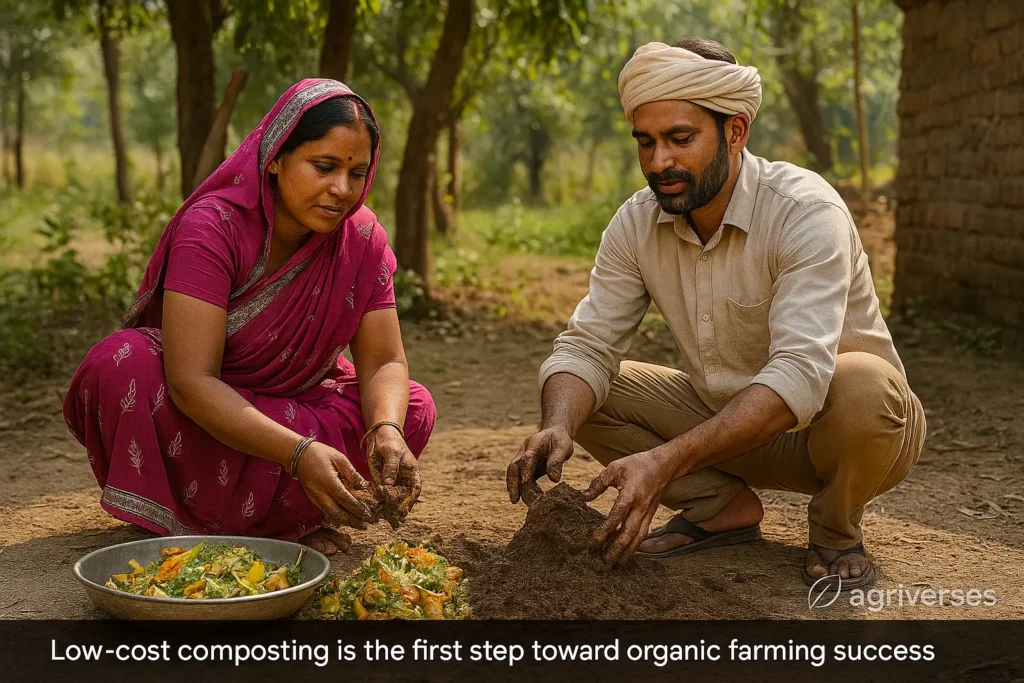Introduction: Myths vs Reality of Profitability

Is farming profitable now? — a question I often hear from farmers I meet, especially those struggling with rising costs of fertilizers, unpredictable rains, and shrinking profits. Organic farming has emerged as a tempting path, but there’s a cloud of doubt: Is organic farming profitable in India?
This article dives deep into that answer this question. We will look at real costs, real income, real success stories, and some very real mistakes to avoid. If you are a farmer or agri-enthusiast wondering whether this path leads to profit or pain, keep reading.
If you want to earn profit, then it is important to take the right training. These are the options for courses: Top Organic Farming Courses
Cost of Starting an Organic Farm in India

Let’s break it down simply. Organic farming is not about going cheap. It is about going smart.
Yes, initially, the cost of organic farming can be slightly higher due to:
- Conversion period (2-3 years where soil transitions from chemical-based to organic) this is most important period where you passion consistency test, because most of the farmer quit organic farming at this stage.
- Certification and documentation costs ( this is actually real concern of small and marginal farmers to continue organic farming)
- Labour-intensive practices
But here is the catch: you save heavily on chemical inputs, and over time, your soil health improves, reducing input needs even further.
For example, a 1-acre organic vegetable farm may require Rs. 40,000–50,000 in the first year for compost units, seeds, fencing, and irrigation. Compare that to conventional input costs of Rs. 25,000–30,000, plus ongoing fertilizer and pesticide expenses.
Within 2 years, organic farms often break even and begin to reduce costs as homemade inputs and soil fertility increase.
Many progressive farmers create their own Jeevamrut, Panchgavya, and vermicompost, reducing dependence on the market. Even items like neem oil, buttermilk spray, and cow dung can be sourced from within the farm or village.
Average Income & Market Demand

Now comes the big question: what about income?
The good news? Demand for organic produce is steadily rising, especially in urban centers like Bengaluru, Delhi, Mumbai, and even Tier-2 cities. Health-conscious consumers, organic food subscription boxes, and direct-to-home models are booming.
A well-maintained organic fruit/vegetable farm on 1 acre can generate Rs. 1.5 to 2.5 lakhs per year depending on crops and marketing strategies. For example:
According to the Indian Council of Agricultural Research (ICAR), organic vegetables can fetch 20–40% higher prices than conventionally grown produce in urban organic markets.
- Organic Turmeric: Rs. 40,000–60,000 per acre
- Organic Vegetables (multi-cropping): Rs. 1.5 lakhs/acre
- Organic Paddy/Wheat: Slightly lower profits but higher net returns over time due to low input cost
Marketing is key. Farmers selling directly to consumers, housing societies, or organic shops earn more than those depending on middlemen.
Case study show organic farming profitable

Let me share the story of Nandlal Yadav, a farmer from Azamgarh, Uttar Pradesh. A few years ago, he shifted 2 acres of his land to organic vegetable farming after suffering major losses due to chemical input prices and declining soil fertility.
In his own words: “Pehle toh lagta tha yeh organic fashion hai, lekin jab mitti ki khushboo wapas aayi, tab samajh aaya yeh kheti asli hai.”
He started with basic composting, cow dung, and crop rotation. The first year was tough — lower yields and skeptical buyers. But he kept at it. By year 3, his brinjal, spinach, and tomato harvests were fetching double the mandi rate via direct sales in Varanasi.
Today, he earns over Rs. 3 lakhs per year from his organic produce, with costs reduced by 40%. He also runs training sessions for nearby farmers.
His advice? “Sabse pehle patience chahiye, phir apna bazaar dhoondo jahan log organic samajhte hain.”
What kind of organic farming idea will work for earning money? See: Project Ideas for Organic Farming
Scientific Explanation: How Organic Soil Health Boosts Profit
Here’s the science behind the sustainability:
- Organic farming rebuilds soil microbial life. Microorganisms like Rhizobium, Azotobacter, and Trichoderma create a healthy ecosystem underground.
- These microbes fix nitrogen, suppress pathogens, and help in better nutrient absorption.
- Organic matter like compost or green manure improves water retention and soil texture.
- Result: lower irrigation costs, better root health, and fewer disease outbreaks.
Over time, these biological improvements mean fewer crop failures, more stable yields, and reduced input dependency. This is where real profitability begins — not just in one season, but year after year.
Common Mistakes & How to Avoid Them
Now imagine this: a farmer quits chemical farming overnight, shifts to organic, but after 6 months says, “Yeh toh ghaate ka sauda hai!” Why?
Here are 5 common mistakes I’ve seen:
- Lack of knowledge — No training or understanding of soil biology and crop planning.
- Jumping in without a market — Growing organic produce without knowing who will buy it.
- Over-reliance on external inputs — Buying expensive “organic” products instead of making Jeevamrut, etc.
- No patience — Expecting immediate results when soil takes time to heal.
- Poor documentation — Skipping certification or record-keeping leads to lack of trust from buyers.
How to avoid them?
- Join local organic farmer groups or attend workshops by KVKs (Krishi Vigyan Kendras).
- Start small (1 acre or less), build your soil, and test your market.
- Use traditional wisdom + modern knowledge (like intercropping, trap crops, etc.)
- Use platforms like Jaivik Kheti portal for marketing and learning.
A Greener, Smarter Rural Future
So, is organic farming profitable in India?
Yes — but only when done with planning, patience, and passion.
It’s not a get-rich-quick model. It’s a get-strong-slowly path. With every compost pile you make, every earthworm that returns to your field, and every consumer who trusts your produce, you are building not just a farm — but a future.
For small and marginal farmers, organic methods reduce input dependency, improve local resilience, and connect them to premium markets. Students entering agriculture today can be changemakers by combining tech with traditional.
The vision? Farms that are self-reliant, sustainable, and in harmony with nature. And profits? They will follow like healthy crops in healthy soil.
Final Thoughts
If you’ve read this far, you already care about real, long-term change in Indian agriculture. I salute you.
If you found this article helpful, please share it with a fellow farmer or agri-student. Let’s create a community of informed, inspired growers.
For more such human-first, experience-backed insights, follow Agriverses or explore our Organic Farming series. The future of Indian farming isn’t far. It’s already sprouting.
Jai Kisan, Jai Dharti.







2 Comments